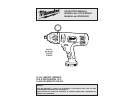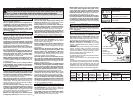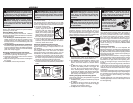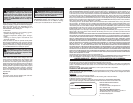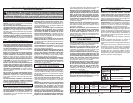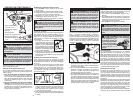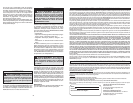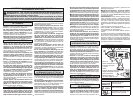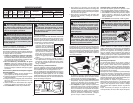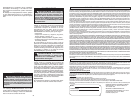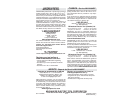
4
5
OPERATION
WARNING To reduce the risk of injury,
keep hands away from the bit and all moving
parts. Always wear safety goggles or glasses
with side shields.
WARNING Always remove battery
pack before changing or removing acces-
sories. Only use accessories specifically
recommended for this tool. Others may be
hazardous.
ASSEMBLY
WARNING Recharge only with the char-
ger specifi ed for the battery. For specifi c charg-
ing instructions, read the operator’s manual
supplied with your charger and battery.
Removing Battery Pack from Tool
Push in the release buttons and pull the battery
pack away from the tool.
Inserting Battery Pack into Tool
To insert the battery pack onto the tool, slide the
pack onto the body of the tool. Make sure it latches
securely into place.
1. For working in restricted spaces. Insert the
battery pack from the front by pressing in the
release buttons and sliding battery pack into
the body of the tool. Insert the battery pack until
clamp engages.
2. For optimum weight distribution and balance.
Insert the battery pack from the back by press-
ing in the release buttons and sliding the battery
pack into the body of the tool. Insert the battery
pack until clamp engages.
Attaching and Removing the Tool Hanger
1. To attach, remove the two top gear case screws.
2. Place the ring through the tool hanger.
3. Position the tool hanger on the tool over the two
gear case screw holes.
4. Replace the two gear case screws. Hand tighten
the screws.
5. To remove, reverse the procedure.
WARNING Always remove battery
pack before changing or removing acces-
sories. Only use accessories specifically
recommended for this tool. Others may be
hazardous.
WARNING Use only sockets and other
accessories specifi cally designed for use on
impact wrenches and drivers. Other sockets
and accessories might shatter or break caus-
ing injury.
Drive
shank
Detent
pin
Fig. 2
Reverse
Forward
Attaching and Removing Accessories
(Cat. No. 0779-20)
This impact wrench is intended only for use with
sockets designed for impact wrenches and that
have a 1/2" square drive. Other sockets could shat-
ter or break, causing injury.
1. To attach a socket or other ac-
cessory, align the hole in the
accessory with the detent pin
on the drive shank. Hold the
detent pin in while pushing the
socket onto the drive shank. The
detent pin will snap into place in
the hole to secure the socket.
2. To remove the accessory, insert
a nail or other thin object into the hole in the
accessory and press the detent pin in. Pull the
accessory off the drive shank.
Attaching and Removing Accessories
(Cat. No. 0799-20, or other Impact Wrenches us-
ing the Quick Change 1/2” Square Drive to 7/16”
Hex Adapter)
Cat. No. 0799-20 is intended for use with drill bits
and adapters with a 7/16” Hex Quick. The Quick
Change shank has a ball-retainer groove. It is not
intended for use with Hex Shank Bit Extensions.
1. To attach an accessory, pull the chuck collar
forward and insert the accessory shank. Release
the collar. It may be necessary to pull the bit out
slightly to engage the holding mechanism.
2. To remove the accessory, pull the chuck collar
forward and remove the accessory. Release the
collar.
Fig. 1
Ball
retainer
groove
Open (Release)
Closed (Locked)
Using the Forward/Reverse Switch
The forward/reverse switch may be set to three
positions: forward, reverse and lock. Due to a
lockout mechanism, the forward/reverse switch
can only be adjusted when the trigger is not pulled.
Always allow the motor to come to a complete stop
before using the forward/reverse switch.
1. For forward (clockwise) rotation, push the
forward/reverse switch in the direction shown.
Check the direction of rotation before use.
2. For reverse (counterclockwise) rotation, push
the forward/reverse switch in the direction
shown. Check the direction of rotation before
use.
3. To lock the trigger, push the forward/reverse
switch to the center position. The trigger will
not work when the forward/reverse switch is
in the locked position. Always lock the trigger
or remove the battery pack before performing
maintenance, changing accessories, storing the
tool and any time the tool is not in use.
Starting, Stopping and Controlling Speed
This impact wrench may be operated at any speed
from 0 to full speed.
1. To start the tool, grasp the handle fi rmly and pull
the trigger.
2. To vary the speed, increase or decrease the
pressure on the trigger. The further the trigger
is pulled, the greater the speed.
3. To stop the tool, release the trigger.
WARNING To re-
duce the risk of injury,
only grasp tool by handle
and red insulated sur-
faces. Do not hold gray
gear case when impact-
ing or drilling.
WARNING To reduce the risk of
explosion, electric shock and property
damage, always check the work area for hid-
den pipes and wires before drilling.
Electric Brake
The electric brake engages when the trigger is
released, causing the socket to stop and allow-
ing you to proceed with your work. Generally,
the socket stops within two seconds. However,
there may be a delay between the time you re-
lease the trigger and when the brake engages.
Occasionally the brake may miss completely. If
the brake misses frequently, the impact wrench
needs servicing by an authorized MILWAUKEE
service facility.
Impacting Techniques
The longer a bolt, screw, or nut is impacted, the
tighter it will become. To help prevent damaging the
fasteners or workpieces, avoid excessive impact-
ing. Be particularly careful when impacting smaller
fasteners because they require less impacting to
reach optimum torque.
Practice with various fasteners, noting the length
of time required to reach the desired torque. Check
the tightness with a hand-torque wrench. If the
fasteners are too tight, reduce the impacting time.
If they are not tight enough, increase the impact-
ing time.
Impacting for two seconds is generally suffi cient for
a 3/8" bolt and one second for a 5/16" bolt. How-
ever, oil, dirt, rust or other matter on the threads or
under the head of the fastener affects the degree
of tightness.
The torque required to loosen a fastener averages
75% to 80% of the tightening torque, depending on
the condition of the contacting surfaces. However,
if rust or corrosion causes seizing, more torque
may be required.
On light gasket jobs, run each fastener down to a
relatively light torque and use a hand torque wrench
for fi nal tightening.



